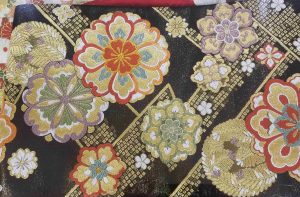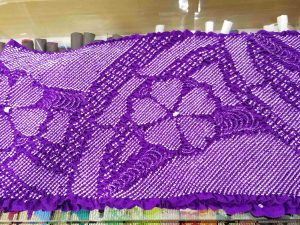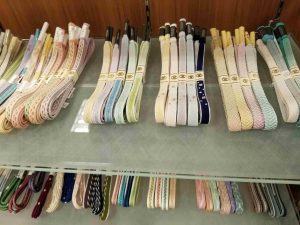Women’s Wedding Ensembles
Whether it’s the all-white Shiromuku, the white kimono covered in a brilliantly colorful uchikake or a gorgeous traditional kimono, you’ll find all the information you need here to understand the basics of the ensemble in the Japanese wedding.
Our goal is to cover all the varieties of the traditional wedding ensemble in Japan. For western-style weddings (usually performed in gardens and chapels), most of the basics of the western wedding are familiar – the white dress, veil, flowers, etc. But for traditional wear, the variety of options is practically endless.
Fundamentals
One of the most critical differences between western weddings and weddings in Japan is that the brides in Japan rarely purchase their formal wedding attire. It is almost all rented and the business of renting wedding ensembles is big! Rental companies usually supply both the men and the women’s ensembles and rental includes everything from the innerwear (except undergarments) through to the accessories (fans, bags, ornaments, etc.). Of course a bride can choose to select a few personal items herself, and they often do, but most of the ensemble is provided by the company.
As a quick background, it is helpful to know that a good kimono can easily run to thousands of dollars. And a wedding kimono is considerably more expensive. The colorful uchikake overcoat is usually hand woven or carefully embroidered and takes hundreds of work hours to produce. These items can also run into thousands of dollars.
Rental fees for ensembles are usually between $1500 to $3000 – so you can imagine what the garments cost. Some outfits can be found for less, but their quality would be considerably lower.
In addition to rental fees, the services of a professional dresser are pretty much required in order to get into the ensemble correctly (what with proper fitting of the kimono and undergarments, tying the obi, accessorizing correctly, fitting the uchikake so it does not get ruined during the day, etc.
Shiromuku
The Shiromuku is the all white ensemble worn primarily for shrine weddings but can also be used for temple weddings. Both the kimono underneath and the overcoat is all white, although some variants have appeared with very small amounts of red, pink or accents of other colors.
The shiromuku can be worn with a range of hair treatments, which are discussed here.
See many more examples of Shiromuku on our pinterest board.
Iro-Uchikake
In this traditional and very formal wedding attire, the bride wears a white kimono and obi, but covers it with a colorful overcoat that can be worn throughout the wedding events or only for the ceremony itself. These are the beautiful wedding ensembles that you will see brides wearing in public temples and shrines, especially on auspicious wedding dates.
Iro-uchikake are always colorful and highly patterned. They come in an unlimited number of colors but red and black are two of the more popular for brides. The crane is considered an auspicious symbol of good luck and large cranes are often seen either in the patterns or embroidery of iro-uchikake.
The Iro-uchikake was originally the formal attire for wives of samurais in the Muromachi period and worn during fall season. They gradually came to be preferred by rich merchants and aristocrats during the Edo period and are now one of the most popular styles of traditional dress for women desiring a traditional Japanese dream wedding experience.
See many more examples of Iro-uchikake on our pinterest boards (arranged by color!)
Hiki Furisode
This is a wedding kimono is similar to the Uchikake in coloring but is just a kimono. So it is colorful, with a colorful obi and many of the same additional ornamentations (fans, wallets, etc.), but there is no overcoat. This is a simpler way to get the colorful effect.
The hiki-furisode has been popular with upper class ladies since the latter half of the Edo period. There are many Hiki-furisode which are embroidered with lucky patterns. They come in a wide range of styles and colors. Black is often popular for this style but the black is almost always accented with bright colors and patterns.
While telling the different between a furisode and a regular kimono can be challenging for someone not used to the difference, the unique point of a furisode is the length of the sleeves. A furisode has long sleeves that hang down. Within this category of kimono there are three types – the most formal is used for weddings. The less formal are using for coming out ceremonies and graduations.
Generally the hairstyle used with this type of kimono is western. Please see this page for flower and hair ornament ideas.
See many more examples of Hiki Furisode on our pinterest board.
The rest of the Ensemble
The kimono is the foundation of all three types of traditional wedding ensemble options and so it helps to know the main parts of the kimono which you will wear.
Traditionally, the art of putting on a kimono was passed from mother to daughter but these days special schools can do brisk business imparting the necessary techniques. The first thing put on are the tabi (white cotton socks); next the undergarments, a top and a wraparound skirt; then the nagajuban, an under-kimono which is tied with a datemaki belt; finally the kimono, with the left side over the right (right over left is only used when dressing a corpse for burial) and tied with the obi. About an inch of the haneri (collar) of the nagajuban shows inside the collar of the kimono. The loose design of the collar is to give a glimpse of the neck, considered the most sensual part of the kimono-wearing lady. When outside, zori sandals are usually worn.

Obi: There are over a dozen different kinds of obi; the one that would be in the rented ensemble would coordinate with the kimono and be the appropriate type (length, width, style etc).

Obiage- a support for the obi. An obiage is an obi ‘scarf’, worn through the rear knot, over the makura, and tied at the top of the sash at the front, then tucked partially behind the sash. The obiage helps hold the makura and the obi’s rear knot in place.

An obijime is an obi cord, worn through the center of the obi’s rear knot and around the center of the sash, tied at the front with the ends tucked into itself at the sides. It helps hold the obi’s rear knot (musuba) and the sash in place.

- Nagajuban-a thin white kimono worn under the kimono, next to the skin to protect the kimono
- Juban—a thin garment similar to an undershirt, worn under the Nagajuban
- Susoyoke – thin half-slip like piece worn under the Nagajuban
- Koshihimo—a narrow sash to hold everything together, as well as to create the extra fold in certain kinds of kimono
- Personal undergarments
Accessories
Accessories
- Tabi socks: White cotton socks with a toe separator so that the zori shoes can fit comfortably
- Zori Shoes: Thong shoes. Usually white but some areas of the country prefer gold. Some ladies choose fully flat zori while others add a small amount of height with a platform heel.
- Hakoseko: The handbag will depend on the ensemble and it’s color. For the all-white Shiromuku, the bag is also white. For the colorful iro-uchikake or the hiki furosode, the bag will often match.
- Kaiken: a small sword (often in a matching case)
- A fan in the obi which is said to represent a happy future.

